21st to 27th August – Middlewich to Anderton and the River Weaver Navigation
We stayed put on Monday and I planned to do some washing but it was a bit overcast so I decided to put it off until the next day, which looked slightly sunnier. Instead, as I hadn’t had time to do much housework over the lock and tunnel-filled weekend, I did some cleaning and sorted out some stuff which needed homes found for them.
By Tuesday, the weather had changed and looked showery but I carried on regardless. Foolishly as it turned out! I ended up having to put the Leifheit Pop-up Airer that I use for my drying line on top of the bed – during a shower, which involved much swearing and grunting! But the rain cleared away shortly after and it was dry for the remainder of the day. Job done.
We set off on Wednesday lunchtime and I took us down to our destination for the day, while Paul worked. I cant quite recall how long ago it was that I last cruised this section of the Trent and Mersey, but it was probably the early 90s! So it might as well be a first voyage! I found it to be quite narrow and reedy/bamboo-ey and went quite badly aground at one point, while waiting for a boat to come through a bridge narrow. This area of Cheshire is famous for its “flashes”. The word “flash” is recorded as being a Cheshire dialect word, used to describe water-filled depressions caused by subsidence.
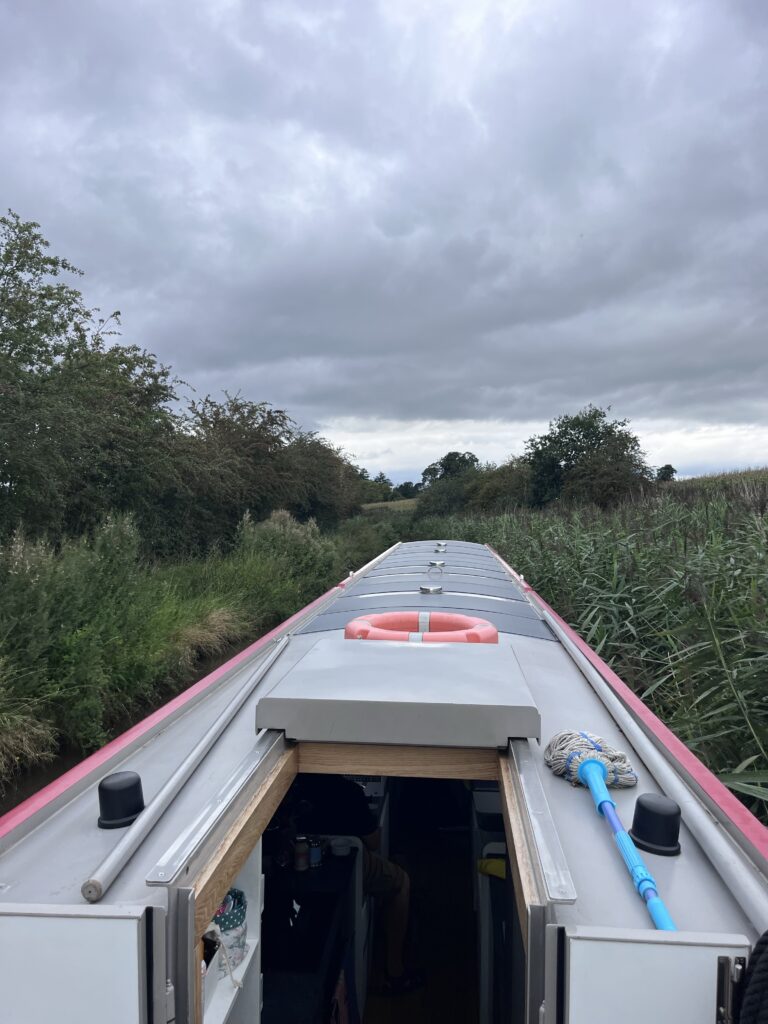
The salt industry in South Cheshire began with the harvesting of natural brine springs but eventually led to industrial scale brine pumping. The practice was particularly common from the 1920s to 1970s in the area around Middlewich and Sandbach, where brine was pumped out of disused salt mine workings. This led to the eventual collapse of the large underground chambers. The resulting subsidence at ground level formed water-filled depressions known as “flashes”. Interestingly, the flashes attract wading birds more commonly encountered in coastal saltmarshes. Several flashes are next to the canal and the larger ones are reminiscent of our beloved Tixall Wide. They are shallow, though, and boaters are warned not to venture in. I clocked some nice moorings by one of the flashes in anticipation of the return journey.
I arrived at our destination, Oakwood Marina, only to find that the berth we had been allocated “between the day boats and the wide-beam” was occupied by another boat. The owner of said boat explained that he had initially been scheduled to leave today but had requested to stay another couple of nights. The manager was not on site so we decided to pop ourselves on a space on one of the pontoons that we had spotted and call the manager for advice. Luckily the berth we were occupying belonged to someone who was out cruising and not expected to return imminently, so we could stay put. Good news.
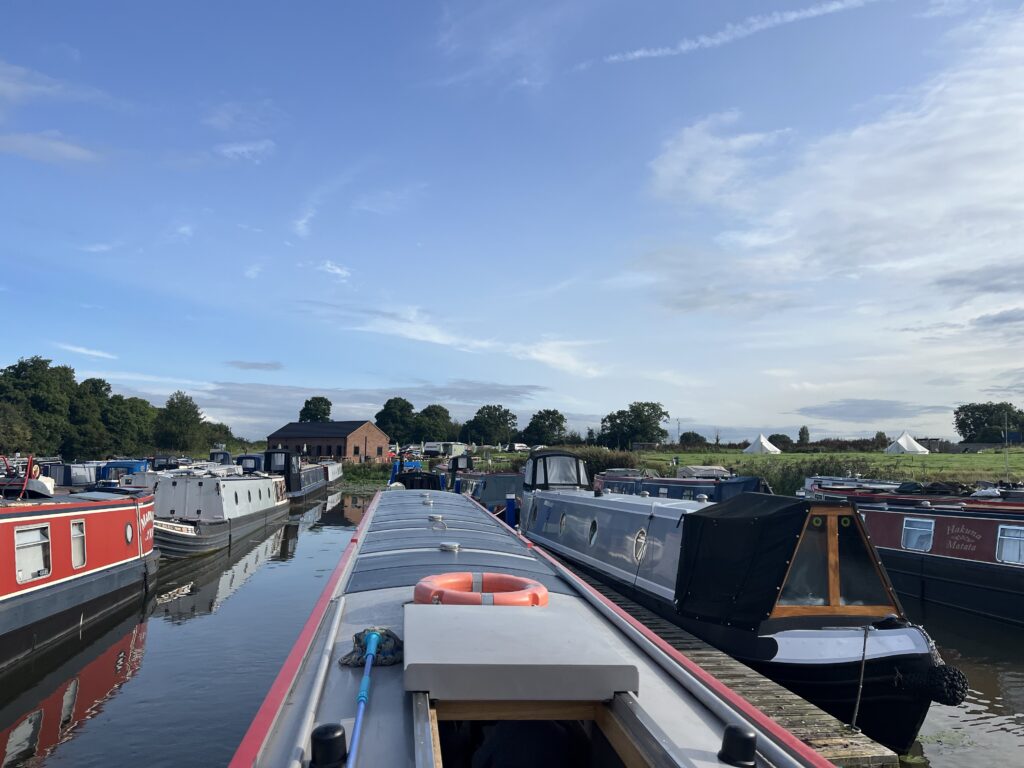
Once we arrived, I quickly threw together a bread pudding, as requested by our incoming guests and started tidying and cleaning ready for Bruce and Lenny’s arrival the next day. They’d be arriving mid afternoon, so I also had some time on Thursday morning.
We found that there was a pizza van on site and a boat with a bar. That sorted dinner! What was planned could keep for another time, Thankfully, all we had to do was turn up and eat it, and no washing up. Perfect. And I can report that the pizzas were delish – perfect thin crust and lots of topping – I went for “al tonno” while Paul had an “ai fungi”. Both were washed down by a cool San Miguel from the bar. Oakwood Marina also has some glamping tents for rent and a space for camping and camper vans. All the facilities (toilet, showers and laundry) look good and the icing on the cake is the tea room, open Thursday to Monday. A nice little spot, we think. And the place has an interesting history but looks as if it might be badly affected by my bete noir – HS2.



Bruce and Lenny arrived after a good four hour drive and we got their stuff stowed aboard and had a restorative cuppa. And then Len got to play with his new, remote control boat, which was great fun but scared the ducks. And Ted. Of course it frightened big, brash Ted!
We had dinner out planned for that night (Yes! Again!) at the Spinner and Bergamot in nearby Comberbach. It was a nice meal with pleasant and attentive waiting staff. The village is also home to the Comberbach Mummers whose motto is “Never knowingly over-rehearsed” – perhaps also the motto of one or two amateur actors I know? I jest, I jest! They put on their ancient show, with its roots in Pagan fertility rites, in October, visiting various pubs. The theme of a Mummer’s play is the cycle of death and resurrection, involving St George and the Devil. It always involves someone getting killed and then being brought back to life by the Doctor. Paul, Bruce and I have all acted in a Mummers Play and it was jolly good fun. We were all in bed by just after 10, as we had an earlyish start the next day.
We slipped our moorings almost on the dot of 9 pm – destination Anderton Lift – about two and a half hours away. We had a passage booked for 12.45pm. It was a first for us and Lenny, but Bruce went with Dad many years ago. The canal passes through some nice countryside and also some very industrial bits. Most notably the Tata Chemical works (previously ICI) which straddles both sides of the canal on the outskirts of Northwich.
We arrived in place with time to look at the Visitor Centre, which has a collection of old (20s and 30s) arcade machines, including the Laughing Sailor, which used to terrify me as a child. Although nowadays, it always reminds me of my old friend Chris Fry, who does an uncanny impression of it, which involves an empty beer glass. And probably a fair amount of alcohol, truth be told.
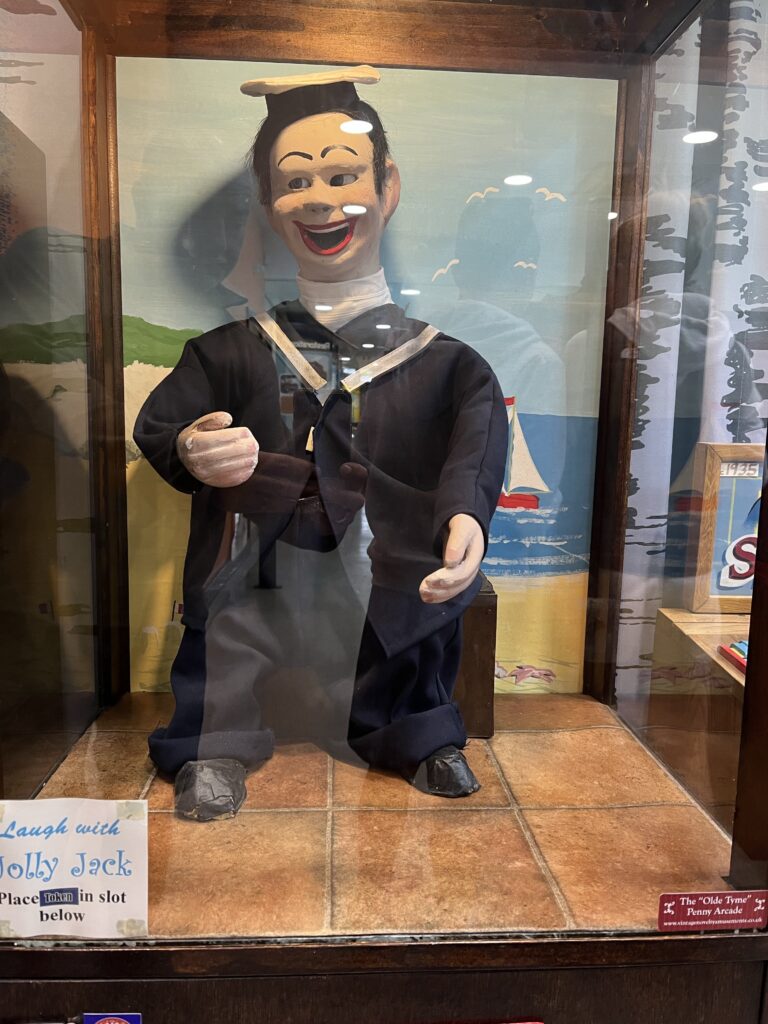
The Anderton Lift is a marvel of Victorian engineering and one of the Seven Wonders of the Waterways – and also one which we have never been fortunate enough to use before. It’s actually a very simple concept. Essentially, it is two huge water tanks, known as “caissons”, each with watertight doors, which originally worked as counterbalances to transport the boats up and down the vertical 50 feet between the Trent and Mersey Canal and the River Weaver Navigation.
The lift was designed by Edward Clark, a noted hydraulics engineer of the time, and opened to traffic in July 1875. The caissons, into which you drive your boat, are 75 ft (22.9 m) long by 15 ft 6 in (4.72 m) wide by 9 ft 6 in (2.90 m) deep. The hydraulics initially used were always problematic and it was later (early 1900s) converted to electric. It operated with very few stoppages for 75 years. It was eventually closed in 1983 as the superstructure was found to be badly corroded and it was deemed unsafe. it did not re-open until 2002 after an extensive restoration project.
But why was it built, I hear you ask? Well the simple answer is salt! The River Weaver joins the mighty Mersey via the Manchester Ship Canal (MSC) near Frodsham (boyhood home of Gary Barlow, who was born there and also home to Daniel Craig, whose father was the landlord of the Ring of Bells pub). Prior to the lift, the laden boats bound for Liverpool or Manchester had to be unloaded, the salt sent down chutes and then reloaded onto to boats below on the Weaver. Very costly and inefficient and eventually the idea for the lift was born.
The lift was closed for a few months recently for emergency repairs and further work is planned. We want to use the lift now as the plan is for it to be taken out of service in 2024 for further “significant” repairs – if the £5 million funding can be secured. You can read more about the history and engineering of the project here.
So – you drive the boat into a tank of water, they close a watertight guillotine gate behind you, give you a safety briefing and some info about how the lift works and then you are off, in your tank, 50 ft down to the River Weaver. It’s actually quite a short trip and there is no real sensation of movement. Pretty soon you are down and then they raise the guillotine gates at the other end of the caisson and out you go! Only one caisson is currently in use and we were paired with another boat for our trip down to the Weaver.
The River Weaver Navigation is another first both for us and also for Old Nick and we were rather looking forward to it. There is one section, described in the Pearsons Guide to the 4 Counties Ring as “possibly the most idyllic moorings on the inland waterways”. Well we’ll be the judge of that! The River Weaver Navigation Society (RWNS) has produced a very handy and informative guide to navigation, which can be found here.
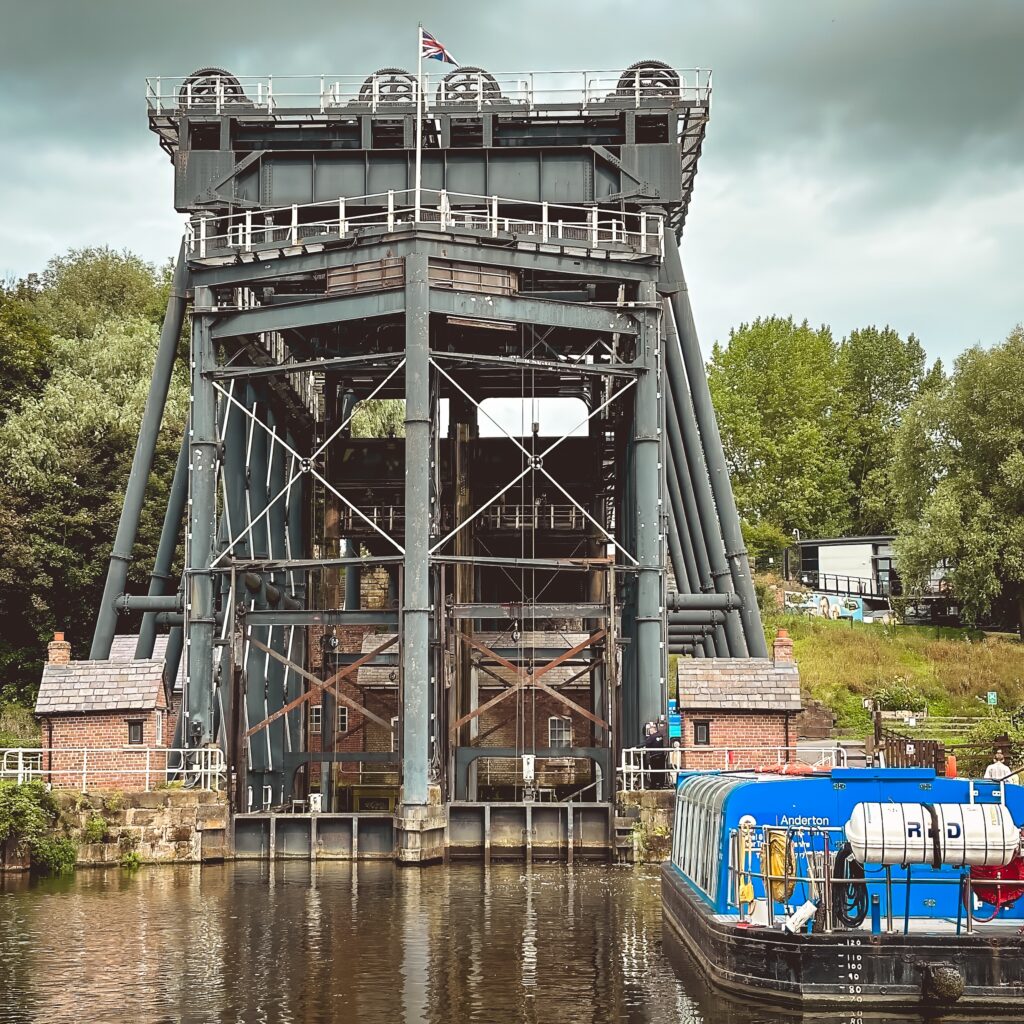
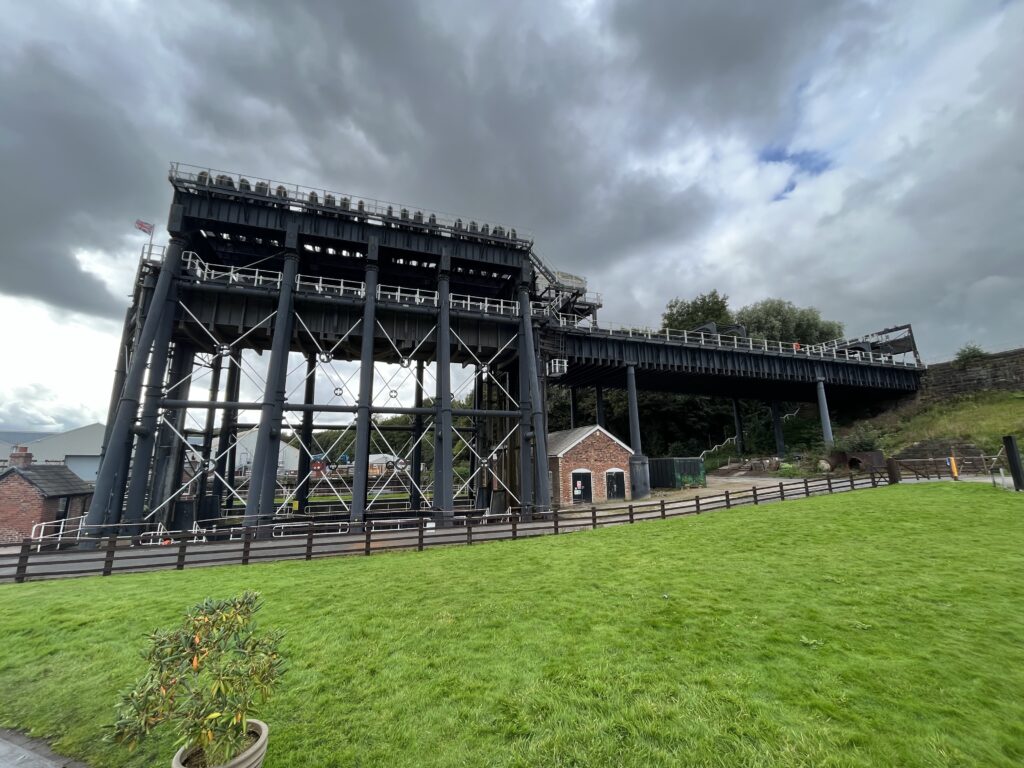
We came out and turned right towards Frodsham and the MSC. It was a bit rainy as we passed through the first very big lock – Saltersford – 213 by 37 feet (65 by 11 m) but soon cleared. It was a very slow lock down because they were only using one of the sluices. Like the Trent and Mersey, the locks are paired although it seems that, today, only one of the pair is currently in commision.
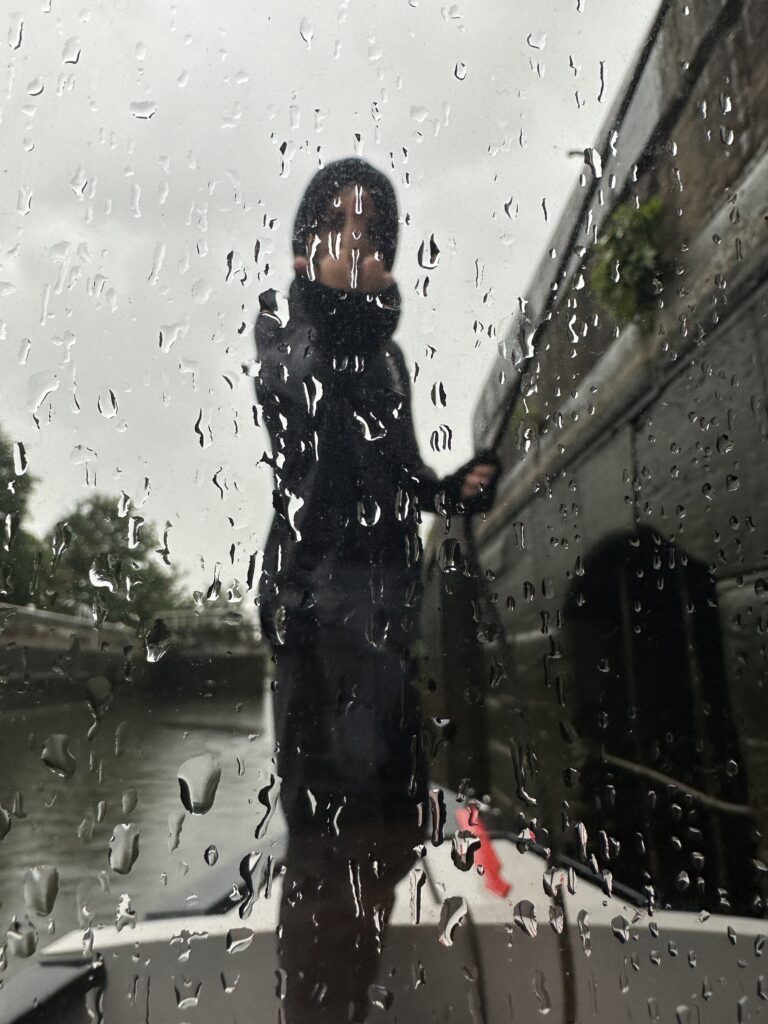
It was about an hour to the next pair of locks at Dutton and as you arrive, you see the wreck of the good ship Chica, originally built in 1894 in Norway. She had a very chequered and fascinating career including service with the German Kriegsmarine, until she came to her rather sad end some 30 years ago.
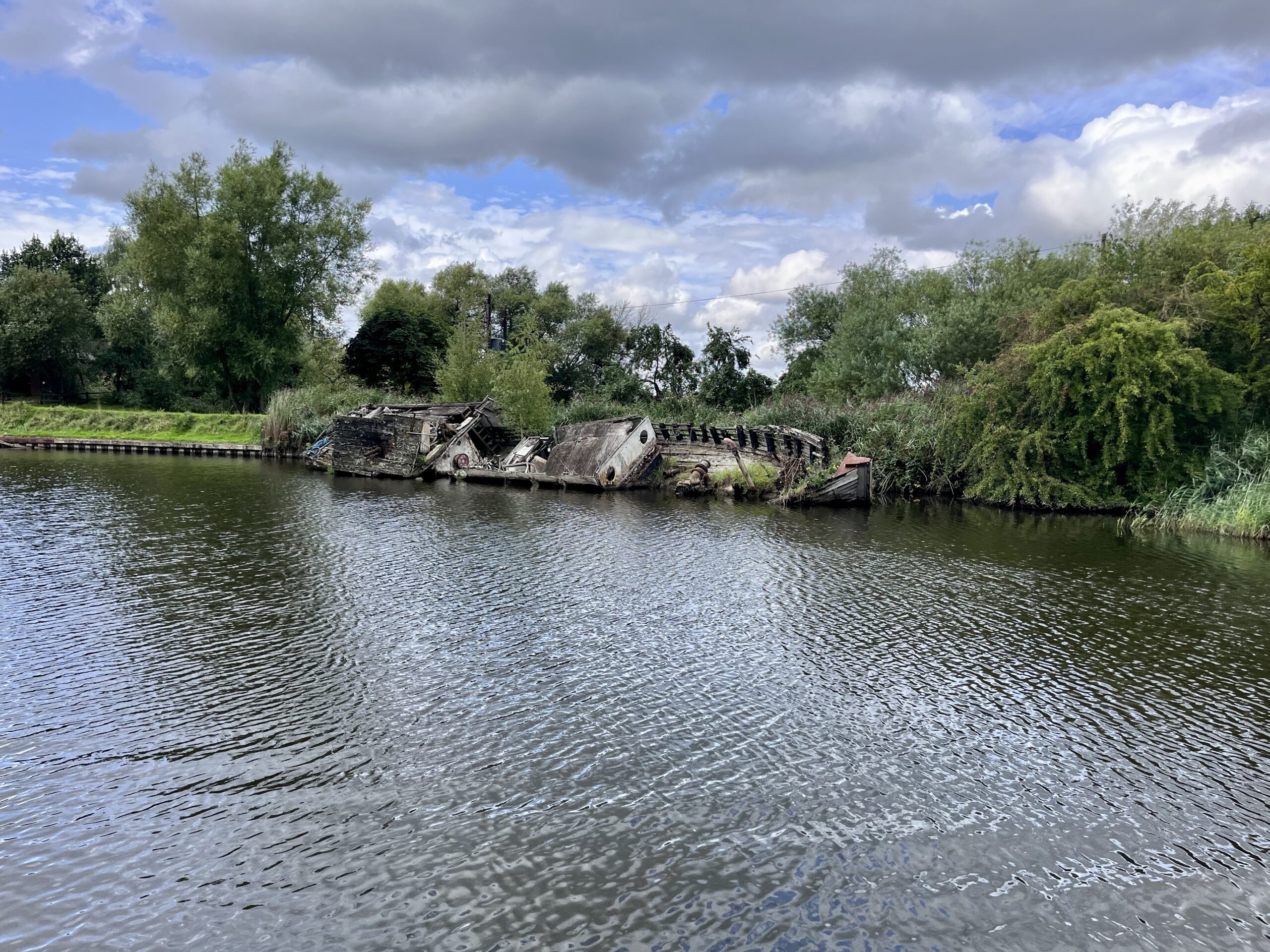
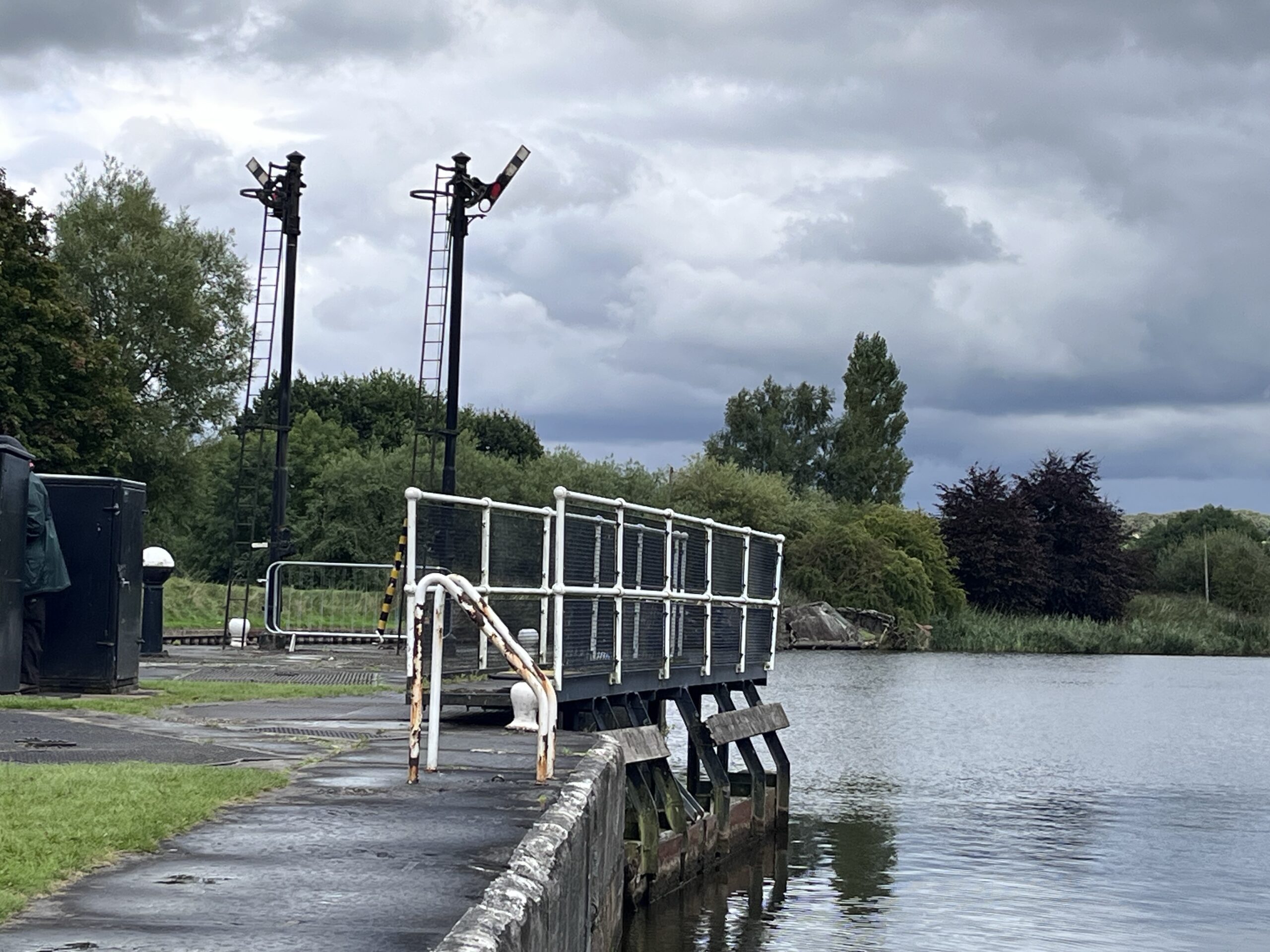
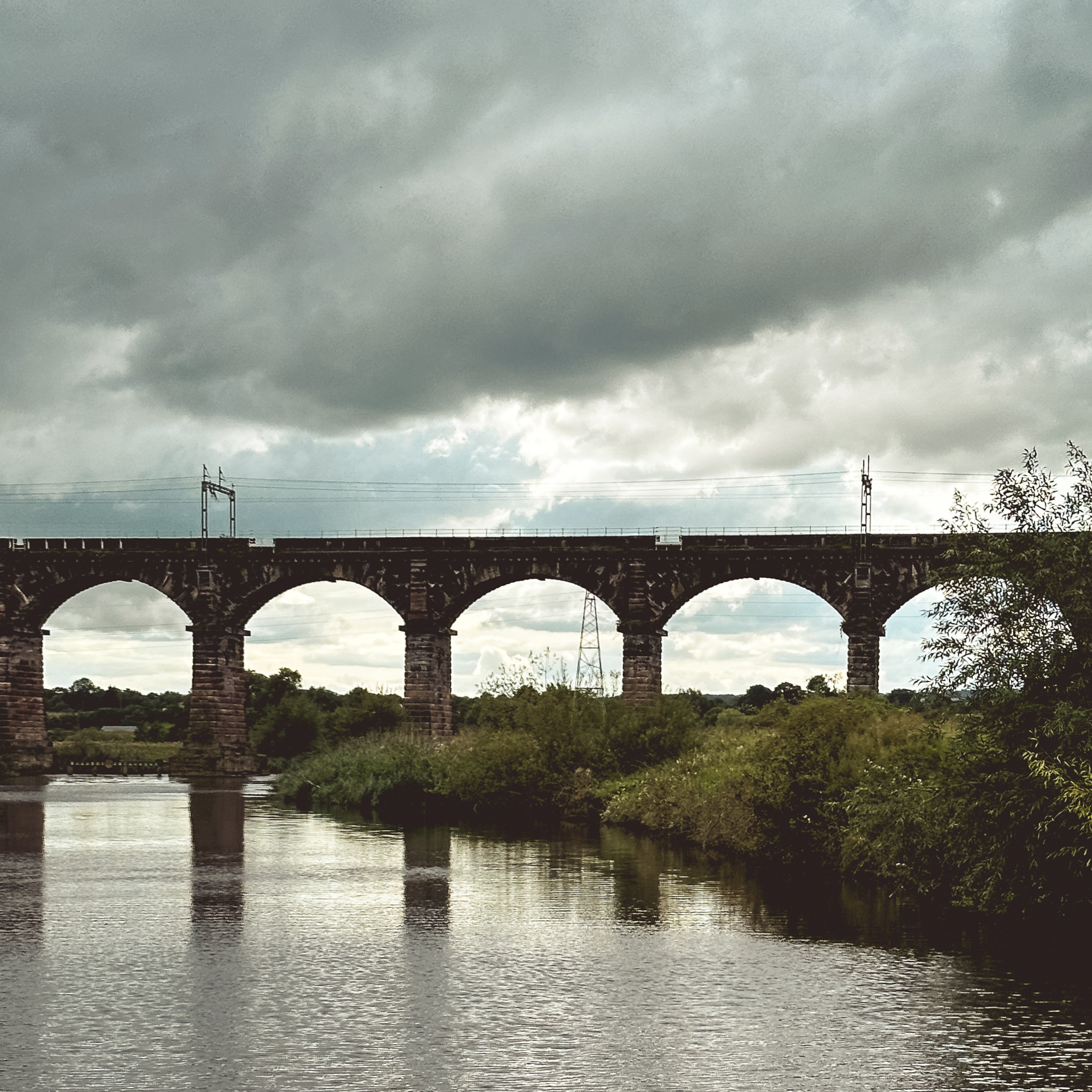
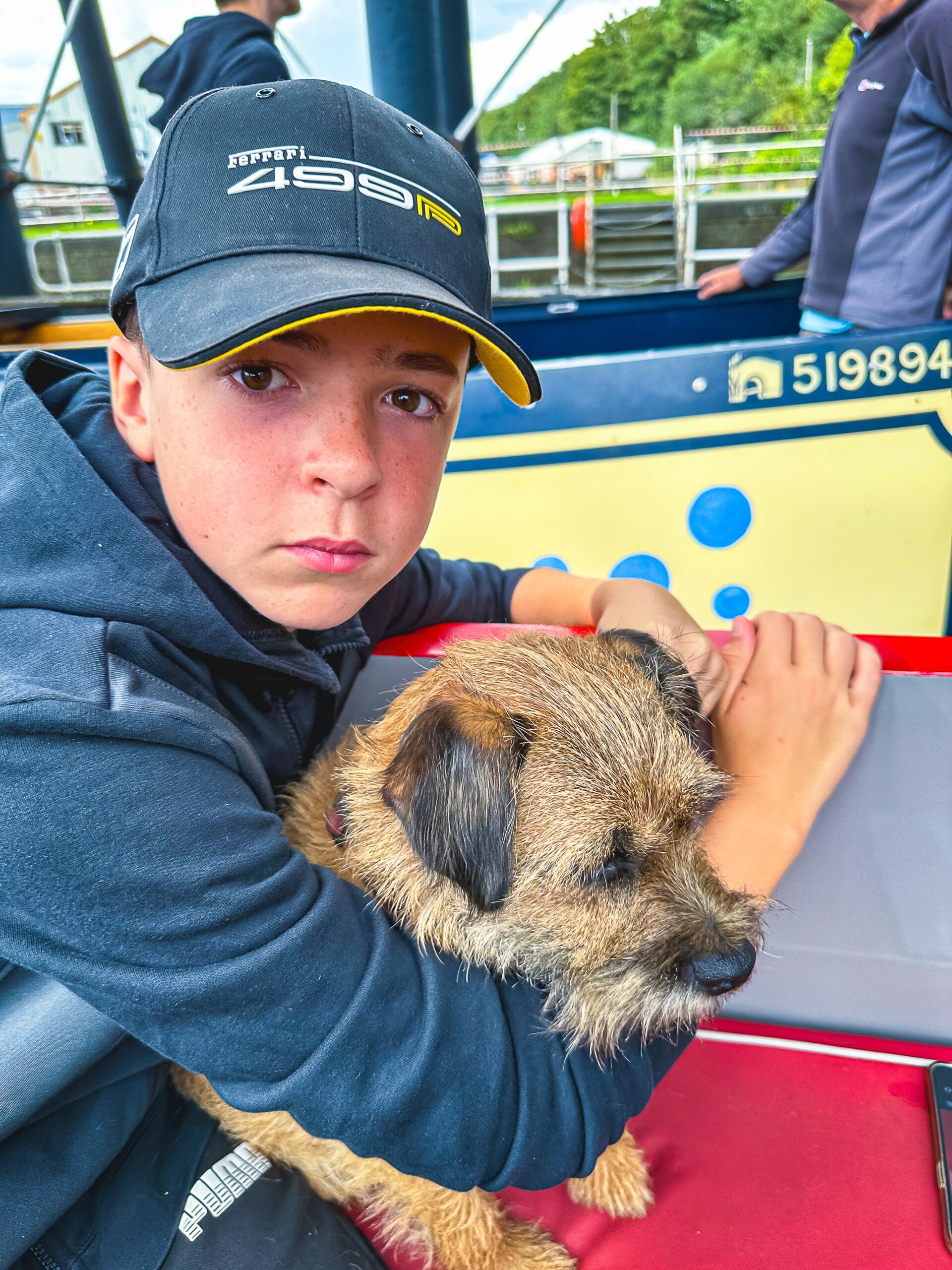
The descent here at Dutton was much faster and the lock keeper told us that each lockful of water is 500,000 gallons! Wow! Unlike most river locks, they have old railway signals instead of traffic lights. Quite quaint. As you exit Dutton locks, you are met with the view of the Dutton Horse Bridge, an attractive two span affair, built in 1919 and also the impressive Dutton Viaduct with its 20 arches towering above you.
We were starting to think about mooring up for the day and planned to moor at a spot called the Devil’s Garden. When we arrived we were sad to see that it was a) pretty dilapidated and more importantly b) there was actually no room for us. We tried several other places but no dice – too shallow, or difficult to get on and off the boat. We finally found a nice quiet spot out in the countryside before Frodsham, where we had more fun with the RC Power Boat and a nosy bunch of cows.
We had a slightly more leisurely start on Saturday morning, although were woken up by noisy rowers from Runcorn Rowing Club, chatting loudly to each other as they rowed past on their early morning row. Really annoying. Our plan for the day was to go down to Marsh Lock (which allows access to the MSC and Mersey) and then on down the Weston Canal to its terminus.
We spent about an hour at Marsh Lock, as there was much to explore. We were pleased to witness the 2,000t MV Scald, listed as a dredger on Marine Traffic, as it came up level with the mouth of the lock and turned before going back down the MSC, destination Liverpool. We could also see planes taking off and landing at John Lennon Airport.
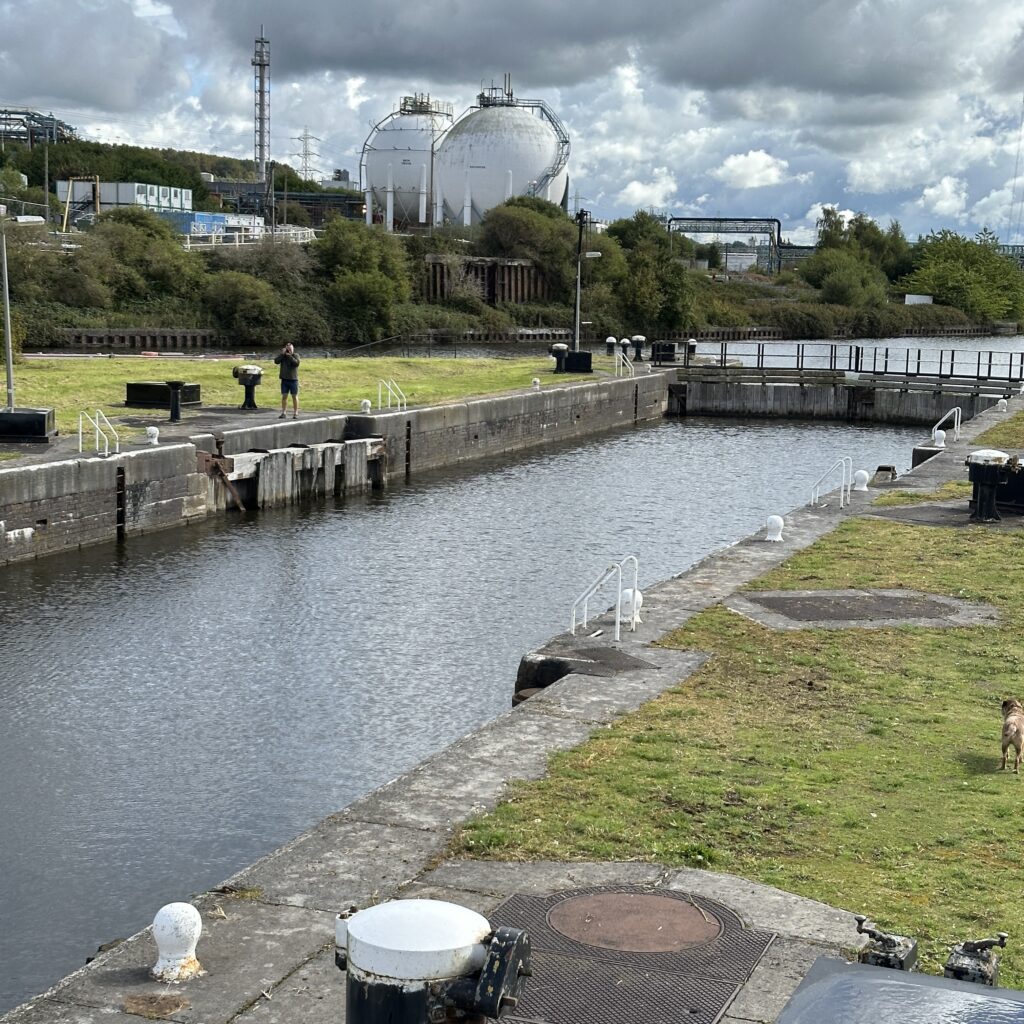
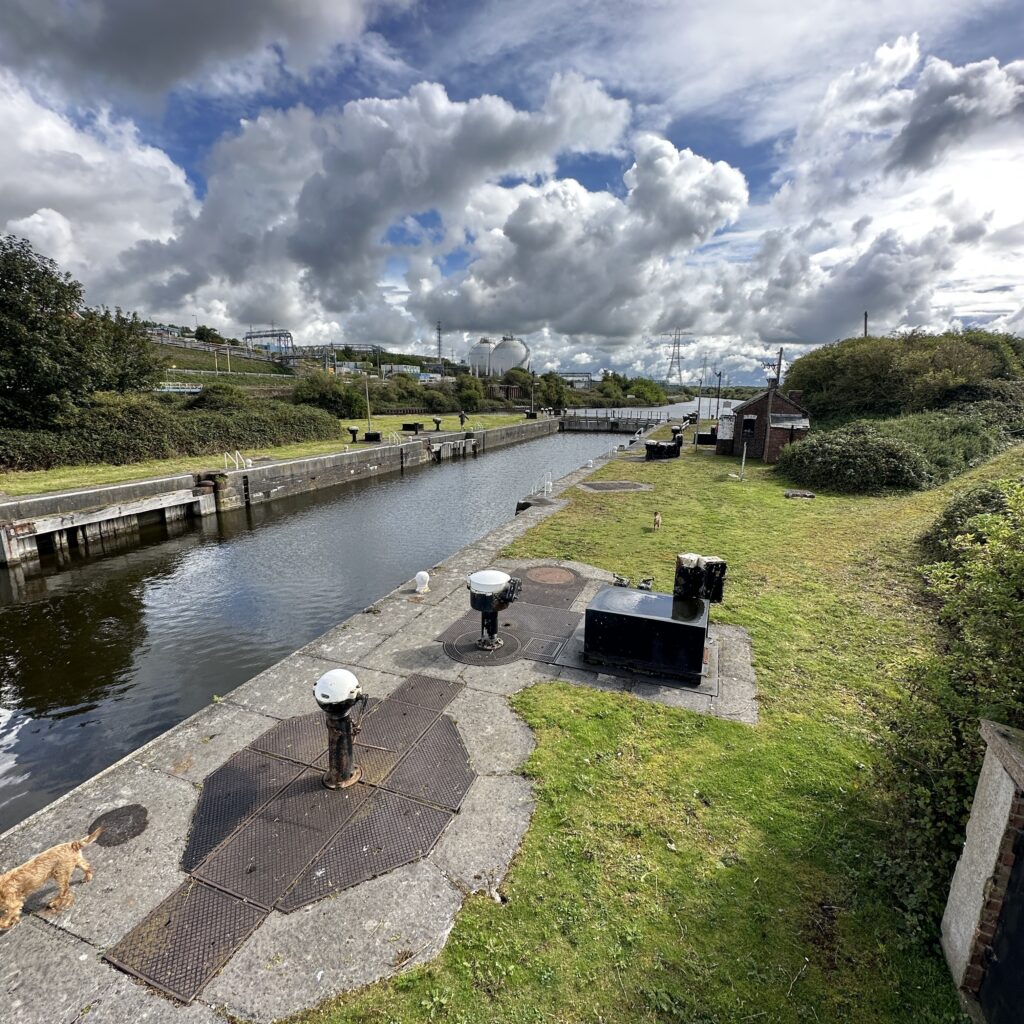
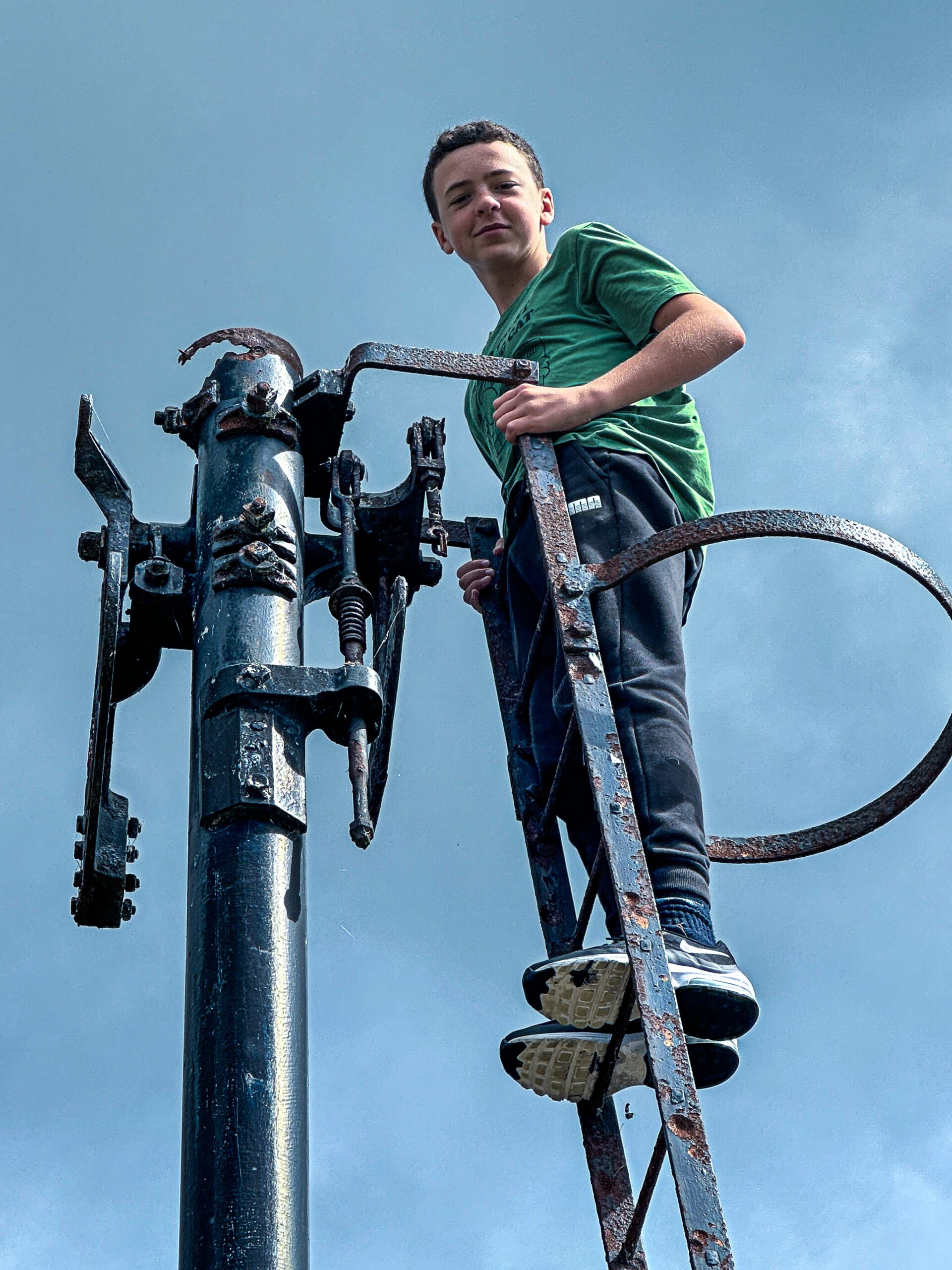
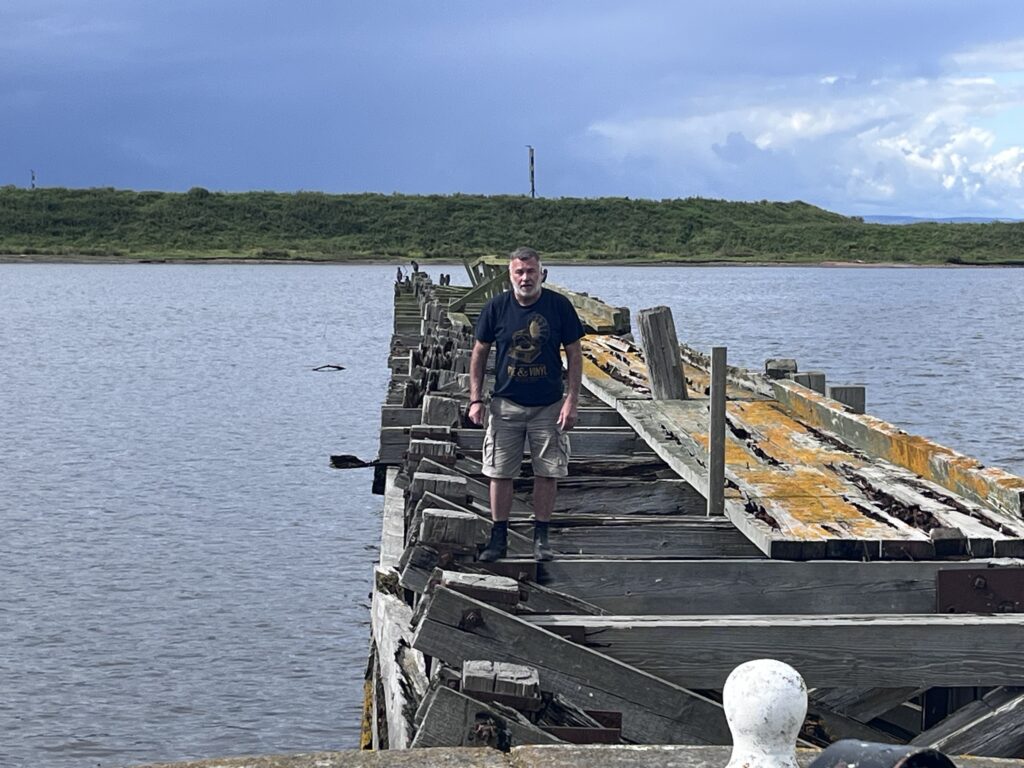
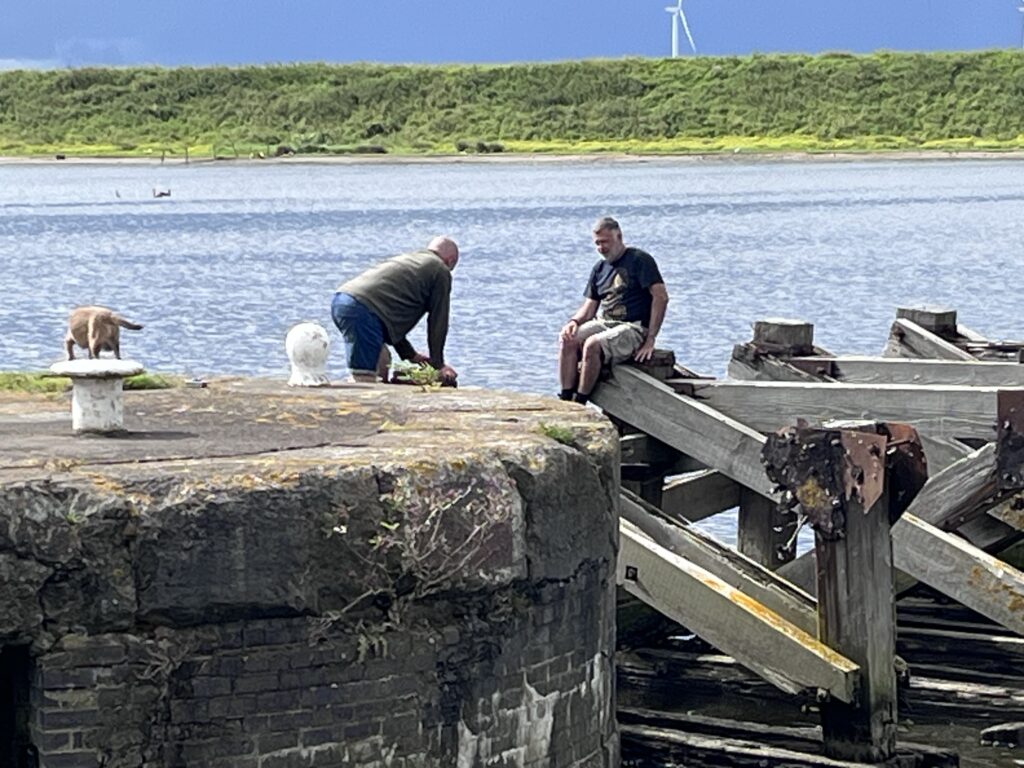
After we’d finished exploring there (and had rescued Bruce from a ricketty jetty) we pressed on to the end of the line. For most of the way we were accompanied by the INEOS Petrochemical Plant – a massive industrial site. I wondered just how many miles of pipe actually were in use there. Quite a few, I’d imagine and they all look so pointless! We were also running parallel to the MSC but we could not see it, apart form a quick glimpse, over the high embankment.
The end of the canal – the very short Weston Canal – which used to lead to Weston Point Docks, is pretty ignominious. A boring, grey swing bridge now prevents you from passing into the docks. We dropped Bruce and Lenny off for a look round and a photo opportunity. then we turned round and retraced our steps.
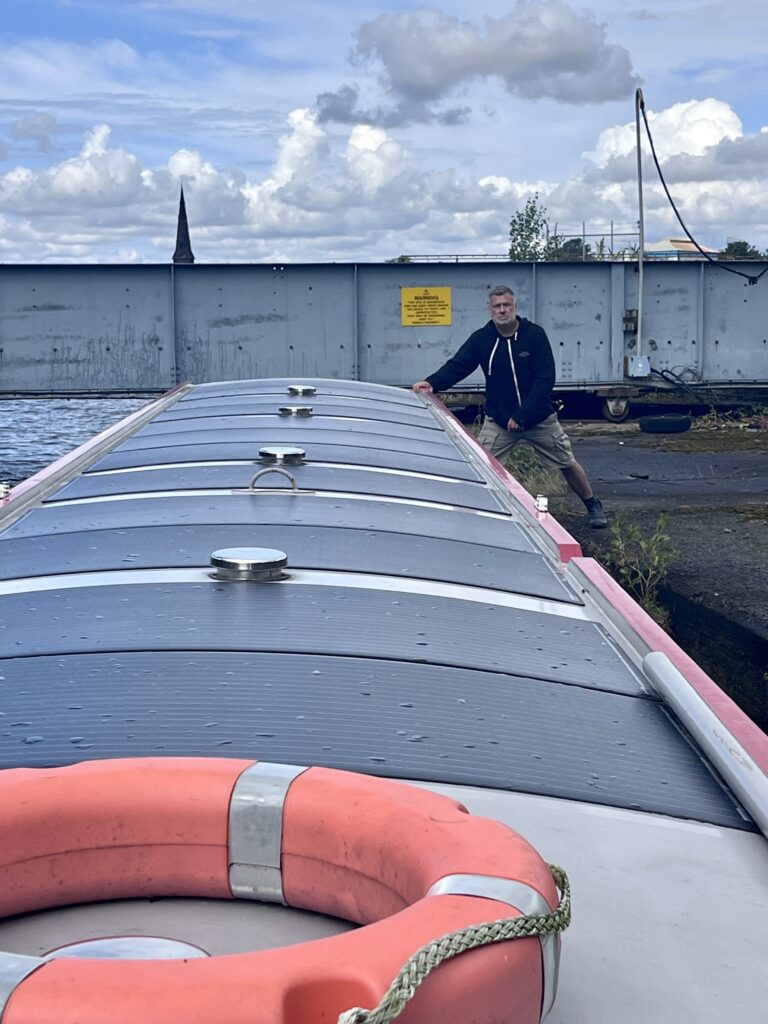
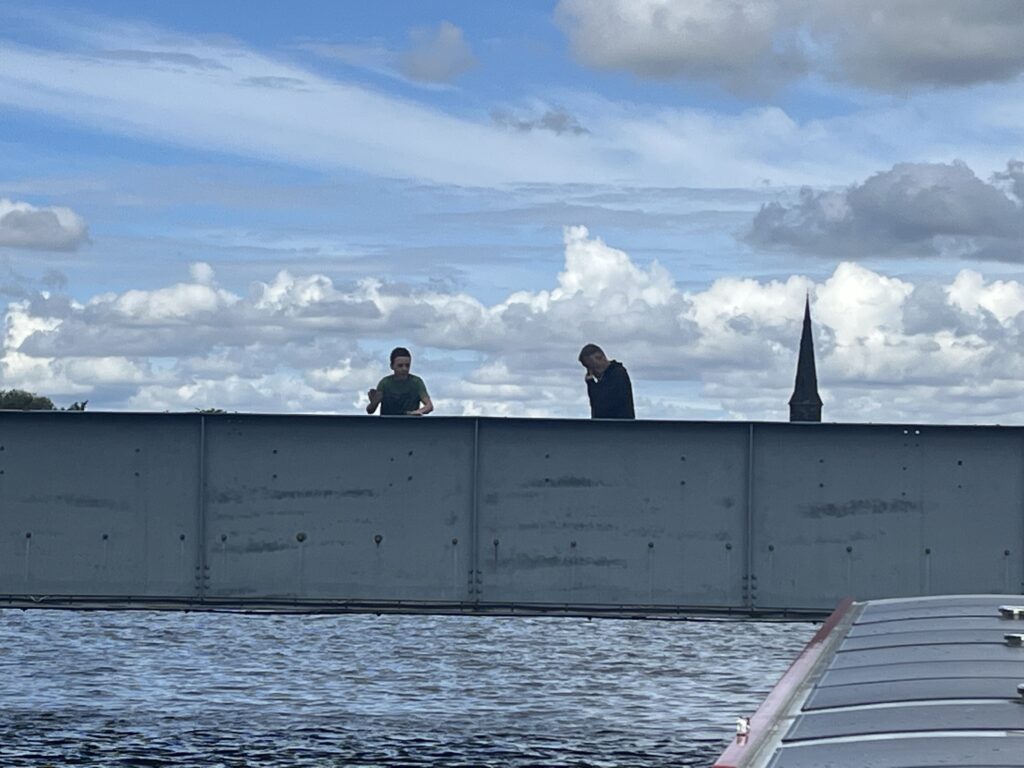
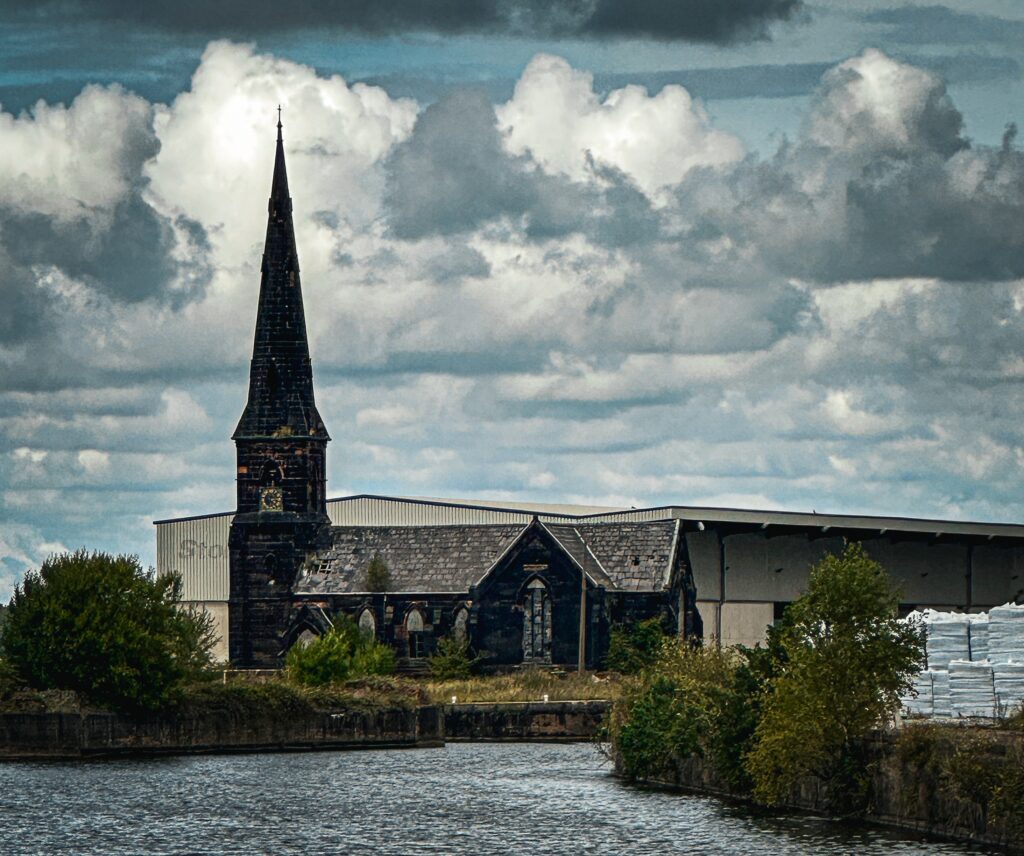
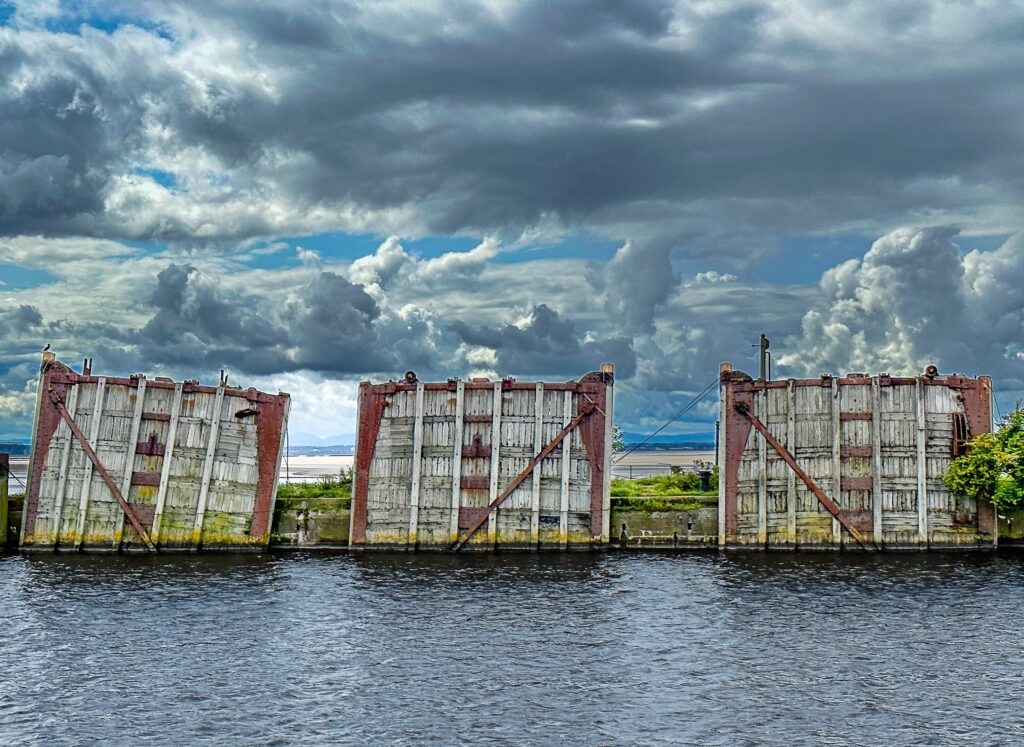
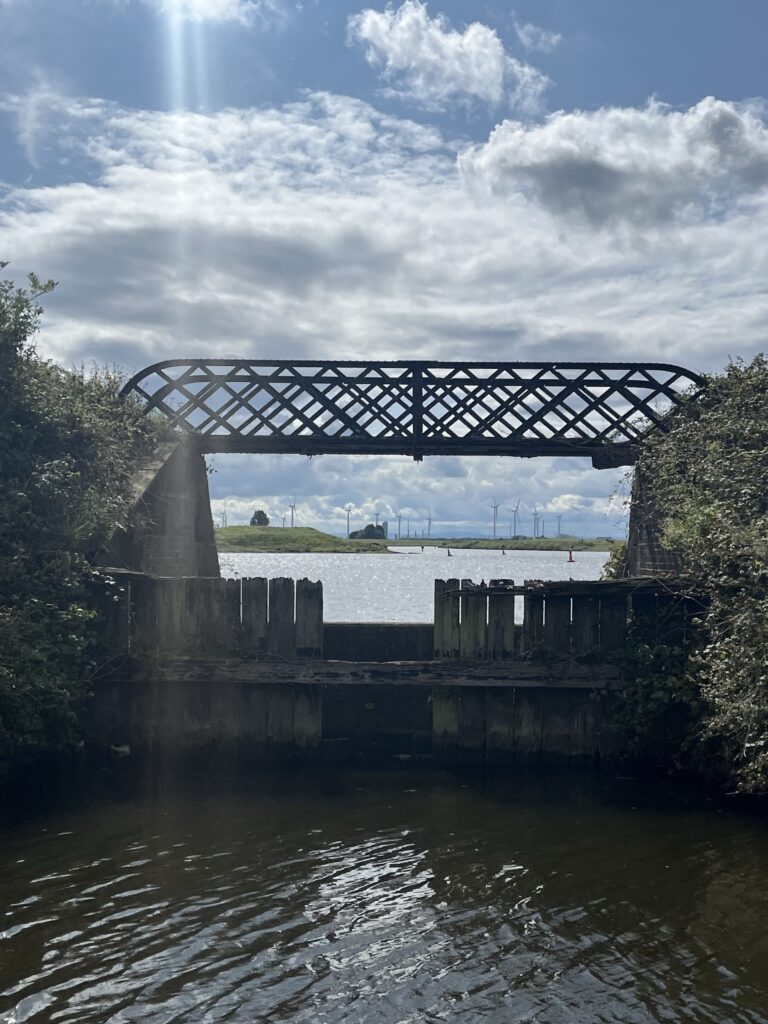
As we approached the Devil’s Garden mooring, we could see plenty of bank and decided to pull over while the going was good. Lenny and Paul went off exploring with the boys while Bruce and I pounded our keyboards for a while. It’s a rather nice, secluded spot and will once again be very quiet.
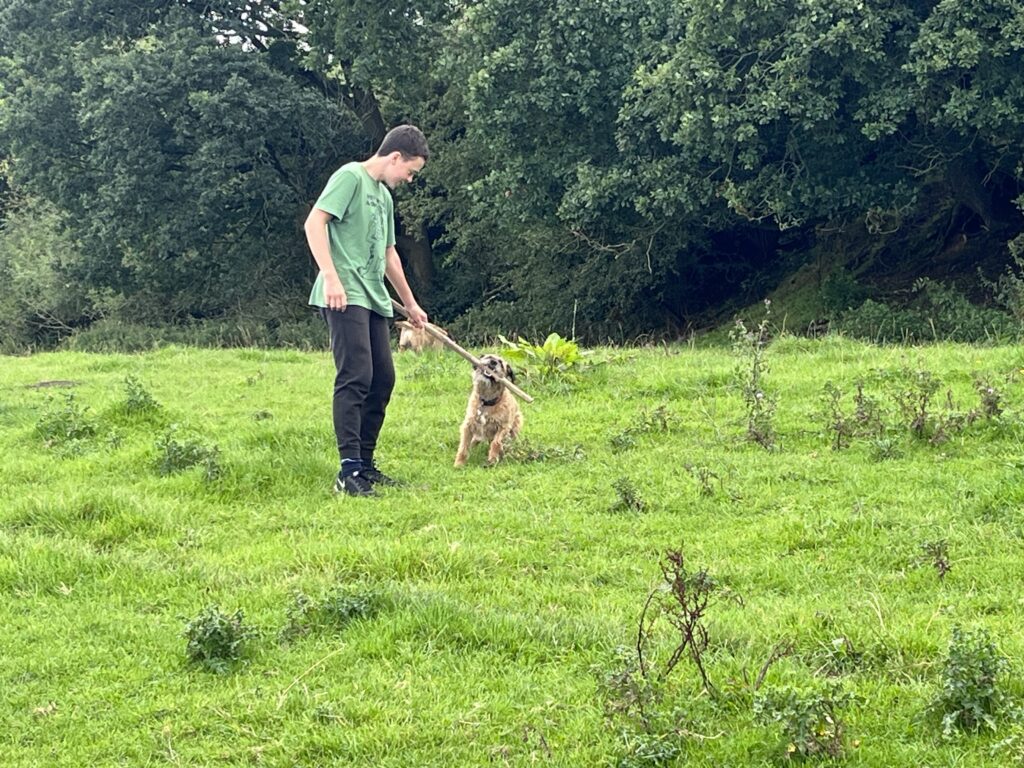

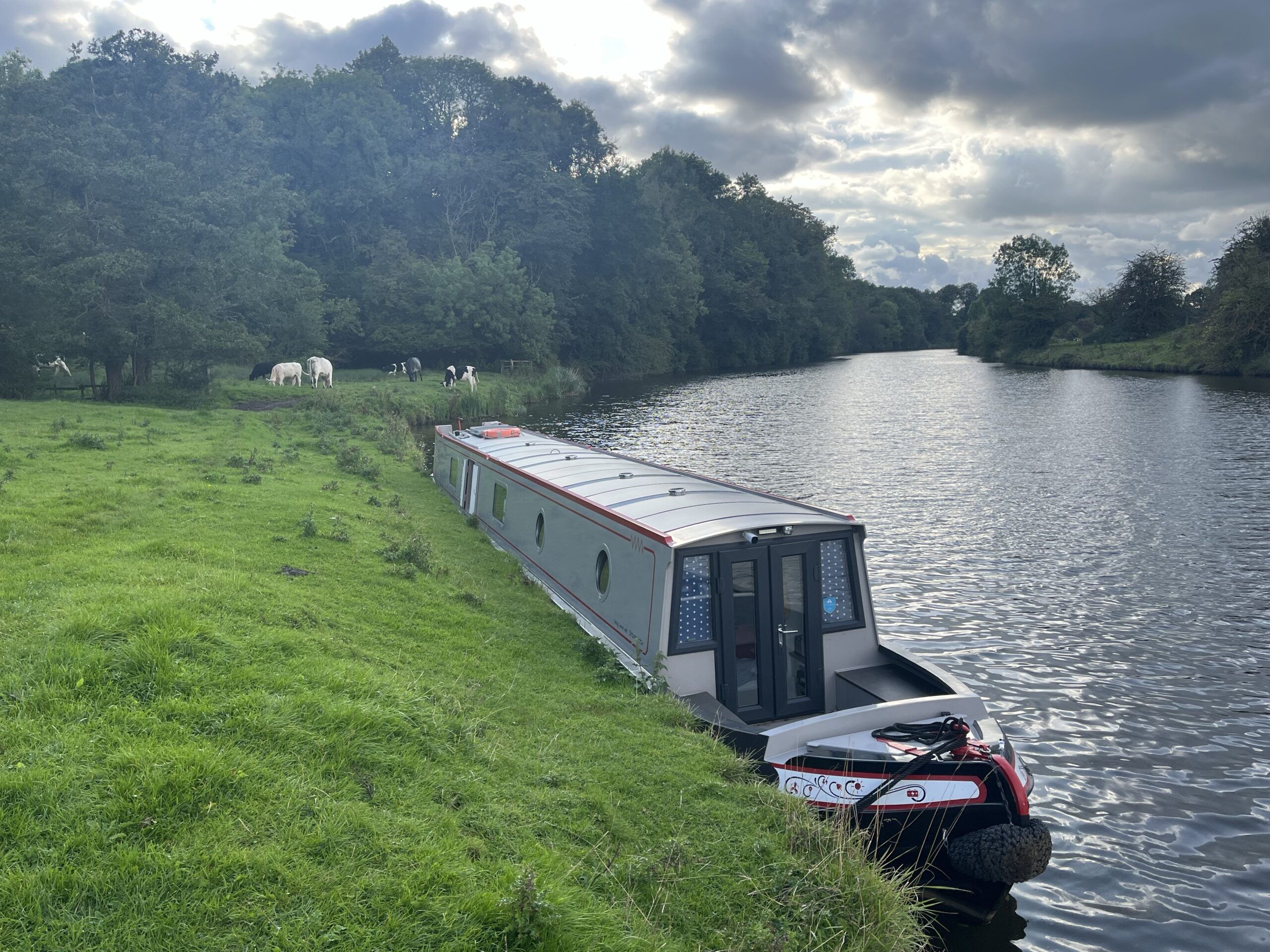
Well famous last words! It was pretty noisy. Creamfields North Music Festival was taking place a few miles away – 8 or 9 – but the noise carried all the way to where we were moored. It took me ages to get to sleep and I think I’d just dropped off in the early hours when the rain started bucketing down! Not the most peaceful of nights.
We continued our passage back up river, through Dutton Locks and – after a long wait – Saltersford Locks. We stopped for Lenny to have a play at the Anderton Lift Visitor Centre play area and then pressed on towards Northwich. We watered and dumped the loo and then found a (probably quite noisy) mooring near the Town Swing bridge. It wasn’t ideal but was a good spot for Bruce to get a taxi from in the morning. We’d had a lovely weekend with them and would be sad to see them go. Unbeknownst to me, Luc, one of our followers on Twitter saw us passing the Lift and took this great shot of us. Thanks Luc.
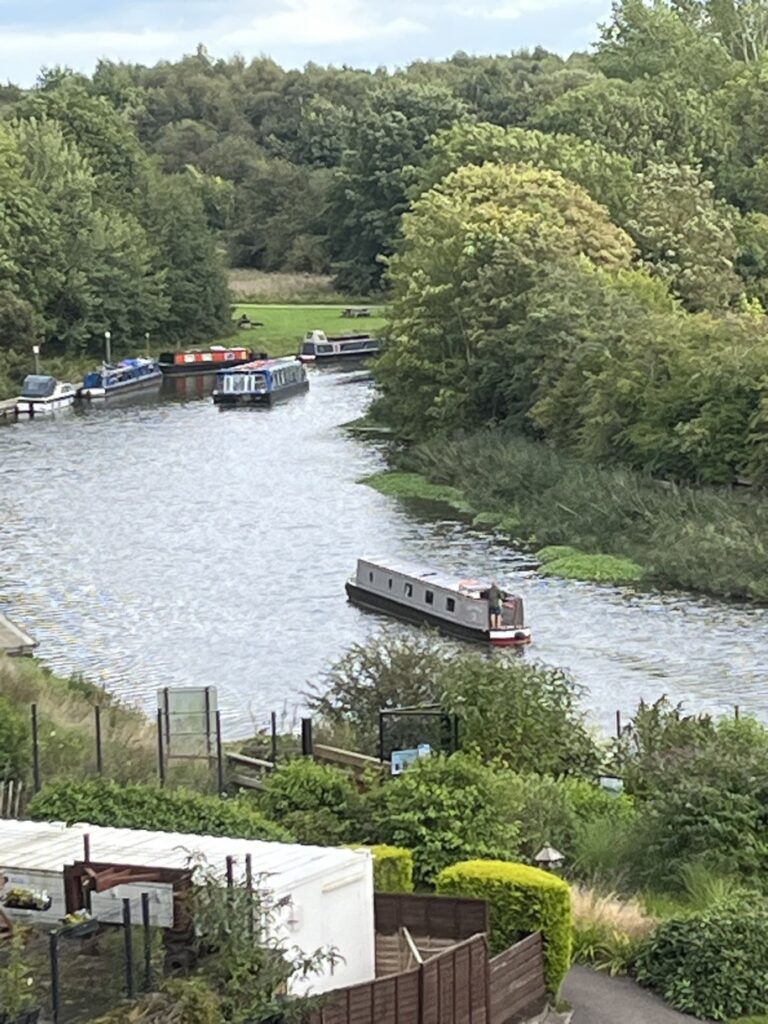
Regrettably, we are prevented from travelling all the way to the southernmost extent of the navigation by the failure of a swing bridge over Vale Royal locks, out of action since early June. This means that we will not be able to visit the idyllic mooring spot mentioned in Pearsons. There’s also a problem with Acton Swing Bridge but luckily we are low enough to fit under without troubling the bridge.
I’d been hoping to see the Danny, a 1903-built steamship that had a very lucky reprieve from the scrapyard, thanks to a bunch of enthusiasts and has been fully restored to her former glory. She is often berthed by Acton Bridge. A quick look at her itinerary showed that she is currently off the Weaver for a while. Possibly because of the problematic Acton Bridge?
It had been noisy on our Sunday night mooring until about 11 pm with what sounded like karaoke from a nearby pub – Sweet Caroline was the last thing I heard! But once that finished, we had as quiet a night as you might wish for.
You can see on the map below that we cruised as far as Whites Bridge (top left) and then just above Vale Royal Locks – bottom right-ish.
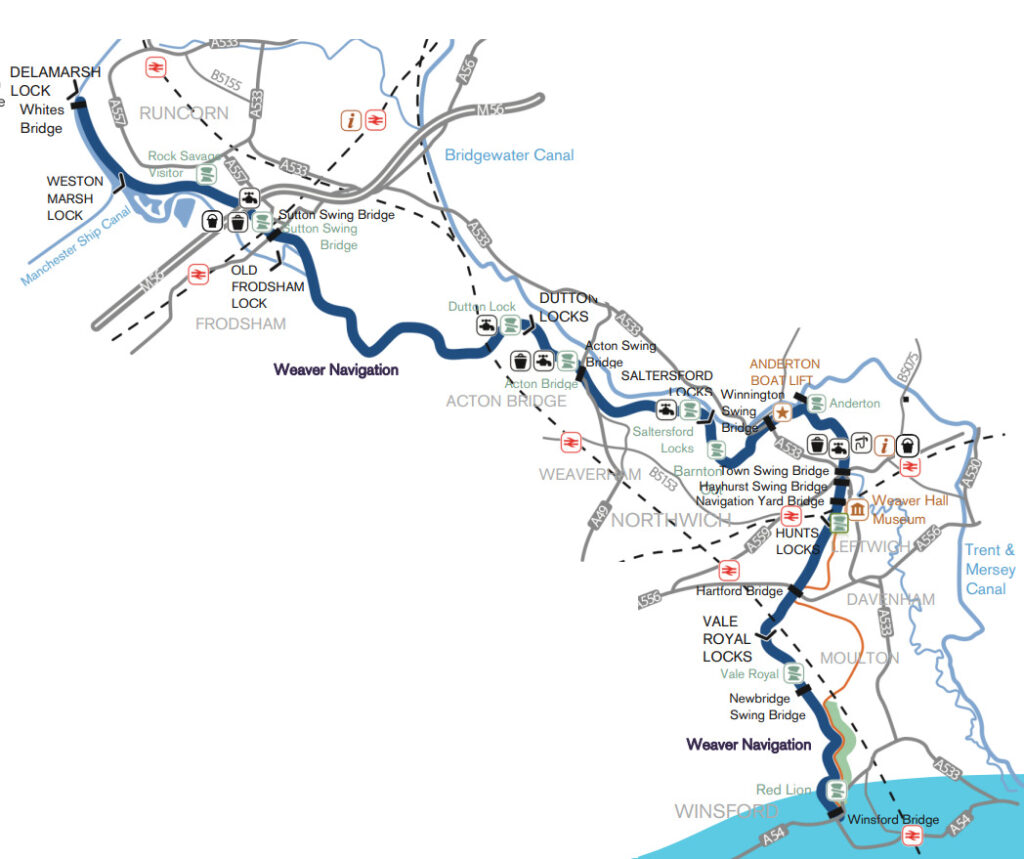
In the forthcoming week, we will cruise as far as we can along the Weaver (i.e. not much further!) turn and take the lift back up to the T&M. We will then follow the T&M to its junction with the Bridgewater Canal before returning to Middlewich and points south of that. Nights are drawing in now – a sure sign that it’s time to start the journey back to our winter base.
| Miles | Locks |
| THIS LEG | |
| 36 | 8 |
| TOTAL 2023 | |
| 461 | 300 |

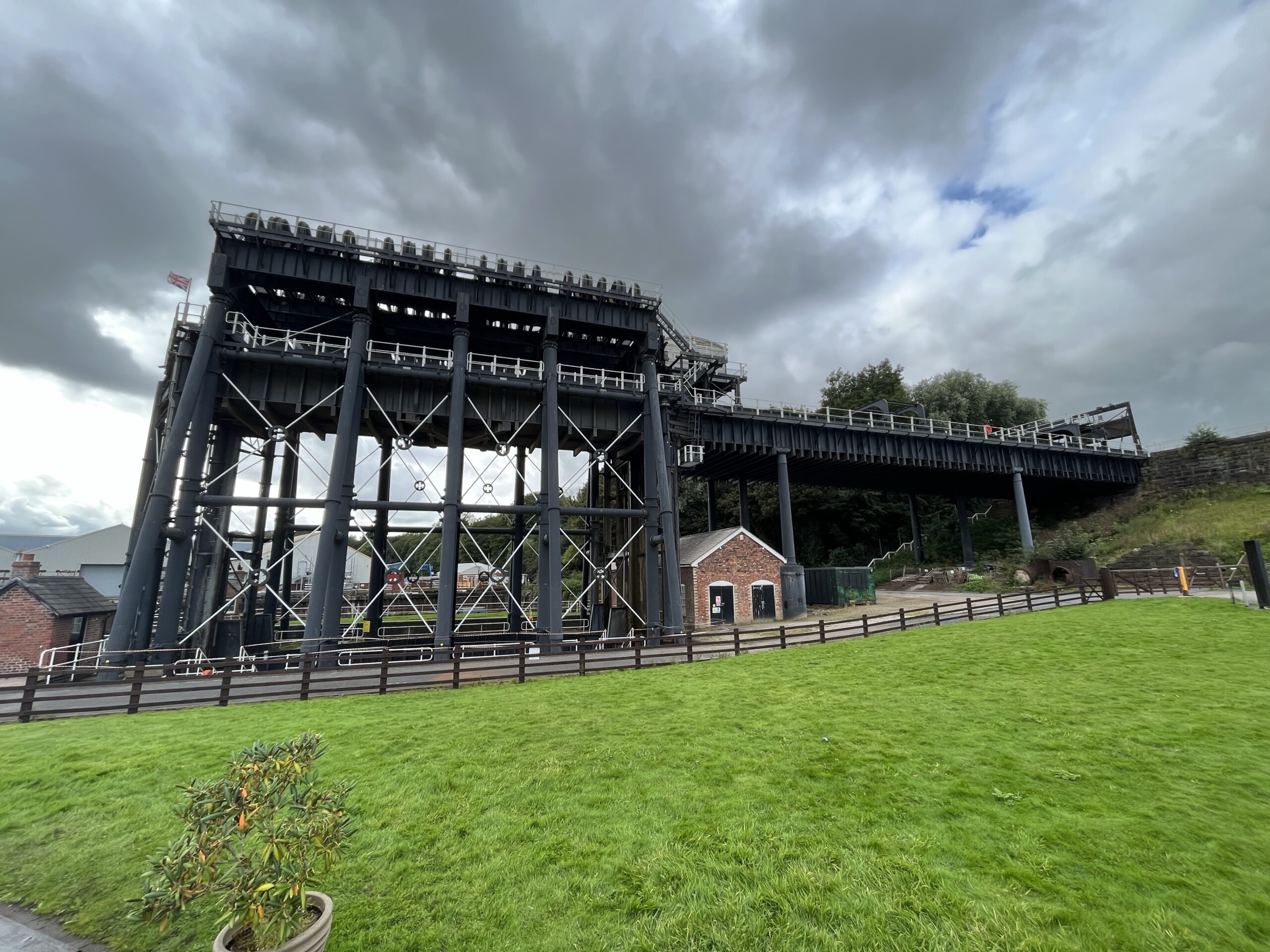
Hi both, it may or may not be a comfort – but when we were on the Weaver a few years ago we found the mooring on the flash at the end covered in goose poo and rather close to roads – is that the one Pearson likkees so much? We muched preferred Vale Royal. also Devil’s Garden (bad luck on the timing!), by Frodsham Cut and Barnton.
Best wishes
Debby
Pearsons waxes lyrical about a stretch near Vale Royal Locks – we assume above as the bit below was nothing to write home about.